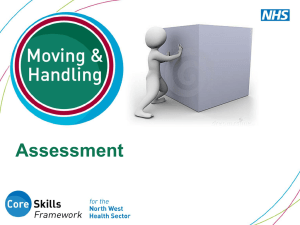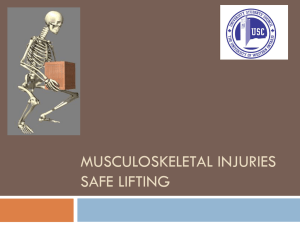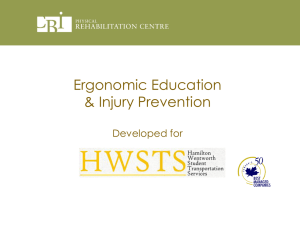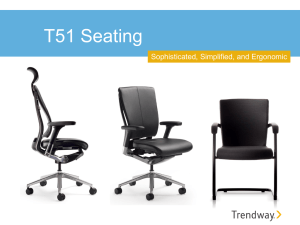Ergonomics Assessment for the Workplace Training
advertisement
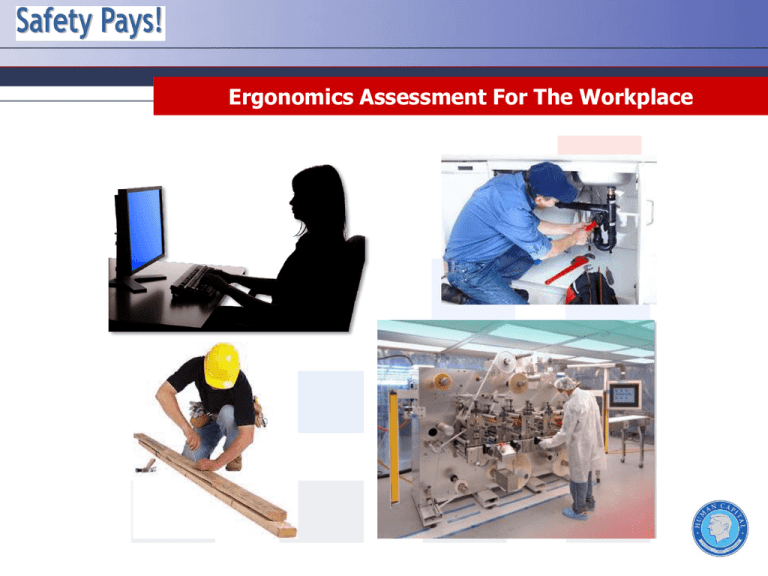
Ergonomics Assessment For The Workplace Disclaimer • This training material presents very important information. • Your organization must do an evaluation of all exposures, applicable codes and regulations, and establish proper controls, training, and protective measures to effectively control exposures and assure compliance. • This program is neither a determination that the conditions and practices of your organization are safe nor a warranty that reliance upon this program will prevent accidents and losses or satisfy local, state or federal regulations. • All procedures and training, whether required by law or not, should be implemented and reviewed by safety and risk management professionals, and legal counsel to ensure that all local, state and federal requirements are satisfied. Course Outline – Ergonomics For The Workplace 1. What Is Ergonomics? 2. Work Related Musculoskeletal Disorders (WMSDs) 3. Types of WMSD Injuries 4. WMSDs Are Caused By… 5. What Factors Contribute to WMSDs? 6. Ergonomic Safety Programs 7. Evaluation and Analysis 8. Applying Ergonomic Controls 9. Administrative Controls 10. Work Practice Controls 11. Summary What Is Ergonomics? Ergonomics is the science of fitting jobs to people: • Ergonomics uses knowledge of physical abilities, limitations, and human characteristics that apply to job design, and “Anthropometrics,” or the study of human body measurement. • Workstations and tasks are then designed around the knowledge of those physical abilities and characteristics. What Is Ergonomics? • Old method: The worker had to fit the workstation. • Ergonomic Method: We fit the workstation to the worker. Work Related Musculoskeletal Disorders (WMSDs) Impact of WMSDs: • Work related musculoskeletal disorders or “WMSDs” can occur from ergonomically-related stressors. Work Related Musculoskeletal Disorders (WMSDs) What are WMSDs? • Musculoskeletal disorders (WMSDs) are injuries to soft body tissues such as: − − − − − − − − Muscles Nerves Tendons Ligaments Joints Cartilage Bursa Spinal discs Types of WMSD Injuries Types/symptoms of WMSD injuries include: • Cumulative disorders, e.g., Carpal Tunnel Syndrome • Fatigue • Eye strain or blurriness • Headache • Strains and sprains • Soreness and/or pain • Connective tissue disorders Types of WMSD Injuries Carpal Tunnel Syndrome: • Carpal Tunnel Syndrome is characterized by compression to the median nerve within the carpal tunnel (wrist). The carpal tunnel is located in that area where a watchband would normally be worn. Types of WMSD Injuries Tendonitis and Tenosynovitis: • Tendonitis is characterized by an inflammation of the tendons. The tendons in the wrists are covered with lubricating sheaths. • Tenosynovitis is characterized by an inflammation of sheaths covering the tendons. • Tendonitis and Tenosynovitis can occur when the demands of the task exceed the physical capabilities of the body. Types of WMSD Injuries Muscle Strains: • Muscle strains and pulls are the most common injuries in the workplace. – Contrary to popular belief, muscle strains and pulls are not always the result of lifting heavy objects. – Lifting below the knee and above the shoulder, as well as twisting while lifting, can increase the chance of a back injury 400-500%. Types of WMSD Injuries Hidden lifting task: • Many stressful working positions are considered "hidden lifting tasks.” • A hidden lifting task occurs when no object is being lifted other than the weight of one’s own body, such as the torso when flexed forward, or the arms fully extended. • As the torso and arms move farther away from the center of the body, more force is applied to the back, and the person experiences greater back-related strain. WMSDs Are Caused By… Overexertion and/or excessive extension: • • • • • • Climbing Bending Crawling Reaching Repetition Vibration • • • • • • Twisting Exposure to hard and/or abrupt contact points Grip size Force of grip Force/Weight Improper body positions WMSDs Are Caused By… Causes and remedies: • Continuous and repetitive motions: – Use lightweight, balanced and sharpened tools to minimize force requirements. • Static body positioning: – Use things such as magnifiers and proper chair adjustments to eliminate the need for awkward body positioning. • Grasping small instruments: – Reduce force exertion and maintain the hand and wrist in a neutral position. • Prolonged use of vibrating hand tools: – • Use vibration dampening devices to minimize exposure. Improper lifting techniques: – . Use proper lifting techniques. What Factors Contribute to WMSDs? WMSDs are medical conditions: • • They develop gradually over a period of time. They do not typically result from a single, instantaneous event. What Factors Contribute to WMSDs? Factors that contribute to elbow injuries: • Sharp or hard contact points and repeated bumping or resting against these points. • Elbows that are held outstretched and far from the body. • Repetitious extending or retracting. What Factors Contribute to WMSDs? Factors that contribute to elbow injuries (continued): • Overexertion of the elbow, due to holding too much weight or holding things far away from the body. • Grip type – something slippery requires a stronger or more awkward grip, which can, in turn, hurt the elbow. • Static or awkwardly-leaning posture. • Awkward lifting angles with arm extension. What Factors Contribute to WMSDs? Video display terminal (VDT) workstation risk factors: • Hard contact surfaces. • Glare in the room. • Wrong desk, monitor, or keyboard height. • Improper chair adjustments. • Poor housekeeping. • Poor posture. What Factors Contribute to WMSDs? Other risk factors • Off-work activities • Sleeping • Diet/physical fitness • Pregnancy • Personal physiology/genetics • Acute injuries Ergonomic Safety Program Goals of an Ergonomic Safety Program: • • • • • Increase awareness of the risk factors. Improve efficiency and productivity. Decrease defects and musculoskeletal disorders, and the severity of each. Reduced insurance costs. Reduced absenteeism due to injury. Increase comfort Decrease risk factors Ergonomic Safety Program Why implement the program? • Improves efficiency and morale. • Increases production capability. • Reduces workplace injuries. • Lowers worker compensation costs. • Reduces absenteeism. • Improved work quality. Ergonomic ErgonomicSafety SafetyPrograms Program Accident triangle: • • • Ergonomic risk factors are at the bottom of the “accident triangle.” The amount of serious injuries can be an indicator of how numerous the risk factors are. To prevent injuries, reduce the number of ergo risk factors! 1 Permanent Disability 10 Time Loss 100 Injuries 1000 Sore Workers 10,000 Ergo Risk Factors Ergonomic ErgonomicSafety SafetyPrograms Program Developing a written Ergonomic Safety Program: • Develop an ergonomics team to assist in identifying caution jobs/tasks, risk factors. • Develop physical demands by task to assure capability of staff to perform duties. Ergonomic ErgonomicSafety SafetyPrograms Program Elements of a successful Ergonomic Safety Program: • • • • • • • Management leadership Employee participation Hazard identification – Discomfort survey – Screening assessment – Application assessment tool (e.g., NIOSH Lifting Equation) Hazard information Medical management Program evaluation Record keeping Evaluation and Analysis Objectives: • Define caution zone jobs and ergonomic risk factors and discuss how they affect the worker. • Review body parts and discuss the risk factors that affect each one. • Review and practice workstation assessment using the caution zone job approach. Evaluation and Analysis Use checklists to identify risk factors: • Identify “caution zone jobs” by performing: – General risk analysis – Task analysis – Workstation evaluation • Knowing the risk factors leads to the selection and implementation of proper controls. Evaluation and Analysis Use a checklist to evaluate: • Lifting • Leaning • Vibration • Work stations • Chairs Evaluation and Analysis Step 1 – Is the task a “Caution Zone Job?” • Does job qualify as a “caution zone job?” • A “caution zone job” is a job or task where an employee’s typical work includes any pre-determined physical risk factors such as: – – – – – – Duration of exposure Force requirements (weight) Posture Repetition Injury data Other Evaluation and Analysis Step 2 – Risk factor reduction: • Use a risk factor identification form to identify all high risk factors including any other possible risk factors. • Identify control approaches for reduction of risk factors. • Get input from the people doing the work. • Follow up to see that controls are effective. Applying Ergonomic Controls • Engineering controls: − Method of controlling exposure by modifying the source of exposure. • Administrative controls: − Controlling exposure by job rotation, work assignment and time periods. • Work practice controls: − Applied work procedures that limit the exposure. Applying Ergonomic Controls In your daily routine: • Ergonomics principles can be applied to the worker’s experiences in the workplace: − Tools and instruments − Workstations − Work practices Applying Ergonomic Controls Tools and instrument design: • To reduce force exertion and maintain hands/wrists in neutral posture, one should look at the tools in regard to: − − − − − − − − Overall shape/size Handle shape/size Weight Balance Maneuverability Ease of operation Ease of maintenance Grip (hand to tool coupling) Applying Ergonomic Controls • Under and over lighted areas cause: − Headaches − Improper body positions − Muscle strains − Fatigue − Eye strain − Glare − Shadows • Poorly lighted areas: – Can contribute to trip and fall hazards. Applying Ergonomic Controls Magnification systems: To improve neck posture and provide clearer vision consider these factors: − − − − − − Working distance Depth of field Declination angle Convergence angle Magnification factor Lighting needs Applying Ergonomic Controls Operator chair: • Assure it promotes mobility, access, and accommodates different body sizes. • The chair should be stable and have five legged base with casters. • Look for: − − − − − Lumbar support Hands-free seat height adjustment Adjustable foot rests Adjustable, wrap-around body support Seamless upholstery Applying Ergonomic Controls Posture and positioning: • Avoid static and/or awkward postures. • Good strategies: − Routinely alternate between standing and sitting. − Alternate tasks. − Take scheduled breaks. − Micro breaks (stand up, walk around, move) Applying Ergonomic Controls A helpful example: • Clinic case study - Naval Station Rota Spain: − A periodic industrial hygiene survey was completed. − Lab techs mentioned chronic back, shoulder, and neck discomfort and pain from working at a non-adjustable bench in obviously stressful static postures. − Also, there was no forearm support nor bench edge padding. Applying Ergonomic Controls A helpful example (continued): • Post intervention improvements: − Offered by Kavo ergonomic lab benches. − Providing ample forearm support and work-piece support centering prosthesis directly below technician which optimizes vertical alignment of the spine, neck, and head. − Lab techs affirm increased comfort and decrease in back, shoulder, and neck discomfort. Applying Ergonomic Controls A helpful example (continued): • Lab technicians now work in optimized ergonomic posture. • In addition to forearm supports and central work-piece support, the table also has much improved overhead lighting, a magnifying lens and a drill speed control operated by the tech’s right knee. Applying Ergonomic Controls It’s important to establish proper: • Desk height • Keyboard height/angle • Monitor height/angle • Chair adjustments (height/tilt/lumbar) • Foot and leg space • Angles Applying Adjustment Ergonomic Controls Controls Chair and desk adjustments: • Chair adjustments: – – – – – • Tilt lock Lumbar height Lumbar depth Chair height Seat pan tilt Desk adjustments: – Drawer configuration – CPU placement – Height Applying Adjustment Ergonomic Controls Controls Establish softeners and other ergonomic devices, such as: • • • • • • • • • Keyboard drawer Wrist rest Mouse wrist rest Alternative mouse Lumbar cushion Seat pan extender Monitor stand Document holders Task lighting Administrative Adjustment Controls Controls Administrative controls include: • Rotating body parts. • Employee job rotation. • Job task enlargement. • Adjustment of the work pace. • Redesigning work methods. • Doing alternative tasks. • Taking rest breaks and doing stretching exercises. Work Adjustment PracticeControls Controls Work practice controls include: • Good work techniques and procedures. • A conditioning period. • Training on lifting techniques and workstation set-up. • Observation, coaching and resources. Summary – Ergonomics Assessment For The Workplace • WMSDs: Disorders such as Carpal Tunnel Syndrome, tendonitis, and muscle strains can develop over time and impact the health and career longevity of people in many different industries. • Ergonomics: Implementing and following proper principles will help mitigate the effects of things like overextension, repetitive motion, static body position and prolonged use of vibrating hand tools. • Ergonomic program: Managers and employees must buy in and support the program so that hazards will be identified and corrective measures taken. • Engineering, administrative and work practice controls: − Workstation layout, both patient and operator chairs, tool design, magnification systems, syringe type etc. − Work methods, task management and physical discipline. Ergonomics Assessment For The Workplace This form documents that the training specified above was presented to the listed participants. By signing below, each participant acknowledges receiving this training. Organization: Trainer: Trainer’s Signature: Class Participants: Name: Signature: Date: Name: Signature: Date: Name: Signature: Date: Name: Signature: Date: Name: Signature: Date: Name: Signature: Date: Name: Signature: Date: Name: Signature: Date: Name: Signature: Date: Name: Signature: Date: Name: Signature: Date: Name: Signature: Date: Name: Signature: Date:

